Lecture
Это окончание невероятной информации про определение фоносемантики.
...
style="text-align:left">
0,0000
Uh
12
0.001
0,0035
2.47
Yu
6
0,004
0,0017
-0.57
YU
eight
0,002
0,0023
0.16
I
41
0.013
0,0119
-0.09
I
44
0.011
0,0127
0.16
Yo
thirty
0.039
0,0087
-0.78
syllable -OP-
65
0,019
syllable - PO-
46
0.013
syllable -YEr
15
0,004
Here we see an excess of the frequencies of the sound letters “B” (deviation from the norm is 50%), “G” (78%), “L” (85%) of the shock “O” (52%), “P” (118%), shock "E" (247%). In the translation of V. Zhabotinsky we see a significant excess of the frequency of the sound "P". This sound is characterized by aggressiveness, sharpness. He is hard, hard. Its combinations with other consonant sounds are defined as gloomy, unpleasant, incongruous. Frequent use of this rolling sound brings tension to the text. It can be concluded that the translator intentionally (or intuitively) chose words with its maximum frequency in order to bring the translation sounding closer to the sound of the original.
In addition, the text of Jabotinsky's translation revealed an excess of the frequencies of the sound letters “Y” (by 78%), “X” (by 48% of the norm), “Y” (by 50%).
All these sounds give the sound a special shade, create a tense emotional background against which the poem takes place, reinforce its semantic side.
Areas of possible use:
1) personal and business correspondence;
2) creating easy-to-learn learning materials;
3) compilation of speeches with predetermined characteristics of the impact on the potential audience;
4) active formation of an emotional attitude towards a politician from various social groups;
5) composing emotionally colored promotional articles;
6) search for the most successful names and brands;
7) psycho-and hypnotherapy;
8) journalism and other areas of activity that use the WORD as a tool.
What is phonosemantic analysis of a word and why is it needed? The easiest way to explain is by example. Suppose you heard the names of two fantastic creatures. One is called Lipel, and the other is Giraffets. Which of them is good and who is evil? The overwhelming majority will say that Lipel is good, and Giraffets are evil. This is phonosemantic analysis. That is, the definition of the quality characteristics of the word, not by meaning, but by sound.
We draw your attention to the fact that if you analyze a pseudonym, first name, last name or middle name, then the result of phonosemantic analysis does not characterize you as an individual. He gives only the phonosemantic description of the word. That is, when people perceive this word, this impression is formed on a subconscious level in most people.
How can this be useful? Knowing a subconscious reaction to a word is useful, for example, when choosing a child’s name or a company (brand) name. Based on the results of phonosemantic analysis, it can be concluded whether the name fits the character of the person. And just wondering what kind of subconscious associations is the name or nickname of the other party!
An example of phonosemantic analysis of the word "Carnaval"
This table provides the full range of phonosemantic scales with the meanings of the analyzed word “Carnival” for each scale. In the coefficient column, the following should be considered: if the coefficient ≤ 2.5 shows the first sign of the scale, if the coefficient ≥ 3.5, the second sign of the scale is expressed, if it is between 2.5 and 3.5, then there is no manifestation on this scale.
For the convenience of your perception, the severity of a sign indicates the presence or absence of the phonosemantic meaning of the word on each scale. The first indicator of the scale is highlighted in blue, the second - in red. Keep in mind that the more pronounced signs - the stronger the emotional and subconscious significance of this word.
| Phonosemantic scales | Coefficient | Graphic presentation | The severity of the trait |
|---|---|---|---|
| Good bad | 2.48 | Good | |
| Big small | 2.48 | Big | |
| Gentle-Rough | 3.49 | Not expressed | |
| Feminine-masculine | 3.75 | Manly | |
| Light dark | 3.14 | Not expressed | |
| Active-Passive | 2.47 | Active | |
| Simple-Complicated | 2.75 | Not expressed | |
| Strong-Weak | 2.71 | Not expressed | |
| Hot Cold | 3.35 | Not expressed | |
| Fast-Slow | 2.77 | Not expressed | |
| Handsome-Repulsive | 2.79 | Not expressed | |
| Smooth-Grungy | 3.21 | Not expressed | |
| Light heavy | 3.06 | Not expressed | |
| Happy-sad | 2.99 | Not expressed | |
| Safe-terrible | 3.33 | Not expressed | |
| Majestic-Low | 2.44 | Majestic | |
| Bright Dim | 2.9 | Not expressed | |
| Rounded-Angular | 3.26 | Not expressed | |
| Joyful-Sad | 2.86 | Not expressed | |
| Loud-Silent | 2.74 | Not expressed | |
| Long short | 3.22 | Not expressed | |
| Brave-Coward | 2.49 | Brave | |
| Kind angry | 3.01 | Not expressed | |
| Mighty Sickly | 2.57 | Not expressed | |
| Moveable-Slow | 2.54 | Not expressed |
The meaning of the word is its content, the sound is its form. The content and form in any phenomenon of reality interact in a very definite way, namely, they always strive for mutual conformity. The content and form of the word should strive for mutual conformity. This correspondence is called motivation, and the word for which this aspiration turned out to be realized, i.e. the content and form of which are in compliance, called motivated. The form of such words seems to suggest their content, and this is very important for the language: a huge number of forms of words and their meanings must be stored in our memory, and we must instantly remember the meanings of any verbal form and the shape of any meaning, otherwise we just cannot operate with the language .
But with the phonetic type of motivation everything is much more complicated. Since, as a rule, we are not aware of phonetic significance, then naturally we cannot recognize the phonetic motivation of a word. It is necessary to “count” many thousands of words, because only great material will reveal some common language tendencies. (A.P. Zhuravlev. “Dear word, do you fit your face?”)
A language, by virtue of its communicative function, serves a person not only to express a thought, but also to convey his attitude to the person expressed, that is, his feelings, ratings, desires, and emotions. These inherent factors arise due to the fact that the objects displayed by us really affect, express our needs and interests, connection with the world, attachment to it.
Meaning is one of the most controversial and controversial problems in the theory of language. The question of determining the meaning of a word (meaning lexical meaning) is widely highlighted in the works of domestic and foreign linguists. However, despite the long history, he still has not received not only the generally accepted, but even at least a fairly clear answer.
Phonosemantics expresses the connection between the sound of the word and the influence it has on the recipient. This direction of the science of language to a lesser extent appeals to the conceptual content of the word, but draws attention to sound as the totality of phonetic elements and their total impact on the listener.
Systems BAAL, DIATON, SLOVODEL, PSYLINE CD.
We formulate our thoughts for transmission to other people in language. It has long been noted that the same thought, but expressed in different ways, has a different power of influence. In one case, it can leave the recipient indifferent, and in the other - to push for action. It turned out that the language of communication, in addition to the obvious semantic content, is capable of transferring latent impulses of influence. There were even science that began to learn the secrets of such an impact.
The most famous of them is Rhetoric - the science of the techniques of oratory.
With the advent of computers, new language analysis features have appeared. The fact that it used to be practically inaccessible due to the large labor intensity is now easily solved by the hard workers-computers. Computer programs also proved to be an ideal form for mass replication of research results.
In 1992, a group of enthusiasts united to work on the study and computer modeling of the hidden effects of texts on humans. These works were called the VAAL Project. Within its framework, a number of computer programs were created, the most well-known of which are the BAAL and Vaal Toolbox systems.
The program implements algorithms for assessing the phonetic impact on humans of words and texts of the Russian language. The theory of such an impact for the Russian language was developed in the mid-70s by the doctor of philological sciences A. P. Zhuravlev. Similar studies for the Ukrainian language were conducted by V.V. Levitsky.
Diaton
Examination of the texts of suggestions (suggestive texts). Investigates the phonosemantics of the word and gives a conclusion on a variety of scales.
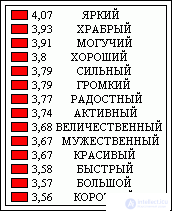
Diaton
The program is a demo version. However, it is useful for analyzing individual words. You can learn a lot about your name, surname, company name and much more.
The very first version of the free VAAL, dated 1994.

VAAL 3 Lite
Version for DOC (operating system before Windows ), works in any version of Windows (98, 2000 or XP). There is no data about compatibility with Windows Vista (above).
The program of phonosemantic analysis of texts. Embedded in Microsoft Word text editor, explores both individual words and the entire text. Can work autonomously. The new version has a support for the Ukrainian language.
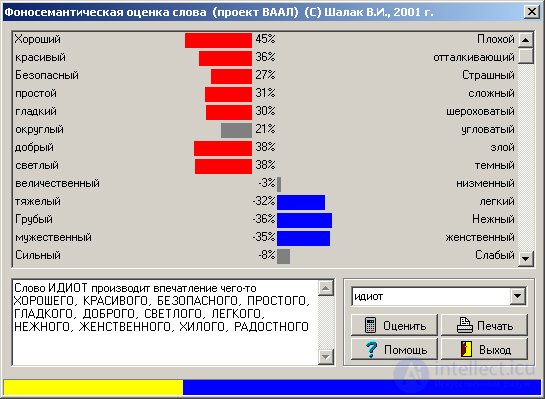
Baal-mini
Identifies sound-sense disadvantages and merits of the text, and will be useful in the preparation of texts of any nature and complexity. Full featured free version. Easy to install, easy to use. Try it.
Psycholinguistic program, consisting of three modules of the study of Russian and English texts. Effectively reveals suggestive bookmarks, repetitions, and may itself synthesize the subconscious components of speech.

Psi Office
The program is free, it works in any version of Windows (98, 2000 or XP). There is no data about compatibility with Windows Vista (above).
In this article I will try to grasp the essence of the methodology of A.P. Zhuravleva designed to analyze the emotional perception of words. The analysis of words can be made by a computer according to the appropriate algorithm and allows the “machine” to understand the emotional component of individual words or the text as a whole.
Please do not "kick" me for this post, because the material can be perceived very controversial, and the results of the application of the algorithm, sometimes give not quite reliable results. Even Artemy Lebedev himself once criticized the BAAL program in which he used this algorithm, and I will not dispute his personal opinion, but I’ll just try to convey the essence of the methodology, and you will either accept or reject the entire responsibility. said and applicability methods.
The material is mainly based on the book by A.P. Zhuravleva “Sound and Meaning” therefore in the post there will be quotes from the book in sufficient quantity to understand the material.
Each word in the Russian language carries some meaning, something designates and has its own special perception. Have any of you thought why this or that word is pronounced as it is pronounced, why, for example, the lily flower is called lily, and not in any other way? Why the old man, for example, call the word hrych? Why is a word perceived as something rough or tender or bright? You can fend off with the fact that each word has its own meaning! That is why it is called so because it means something concrete and we perceive it that way, but how then to deal with words that do not have any specific meaning? Take, for example, the names of "mamlyn" and "zhavaruga." Which of the names is perceived, in your opinion, as something good-natured, plump? Each of the names does not carry any clear definition or meaning, but undoubtedly Mamlyn is perceived more good-naturedly than the wicked and prickly Zhavaruga.
The ancient Greek philosopher Plato believed that people were free to choose the name of an object, but freedom of choice was limited by the properties of the object and the properties of sound speech, and M. V. Lomonosov believed that speech sounds have some meaningfulness and even recommended using these properties of sounds to make art works more expressiveness.
Постулируется, что значение слова определяется свойствами отдельных звуков и их сочетаний.
Был проведён эксперимент — группе людей давали для оценки пары слов с разными звуками (бод — буд, быд-бед) и просили оценить каждое из слов по разным шкалам «Большой-Маленький», «Хороший-Плохой» в результате была составлена статистическая закономерность звука в слове и его значения.
Журавлев предложил оценивать звуки по шкалам и в результате множественных экспериментов были составлены шкалы и оценены все звуки русского языка, в результате чего была составлена обширная таблица с оценкой каждого звука по 25 шкалам
| good | плохой |
| красивый | отталкивающий |
| безопасный | страшный |
| радостный | печальный |
| светлый | темный |
| легкий | тяжелый |
| безопасный | страшный |
| добрый | злой |
| простой | сложный |
| гладкий | шероховатый |
| округлый | угловатый |
| большой | little |
| грубый | gentle |
| manly | женственный |
| strong | слабый |
| холодный | горячий |
| величественный | низменный |
| громкий | тихий |
| могучий | хилый |
| веселый | грустный |
| bright | тусклый |
| подвижный | медлительный |
| быстрый | медленный |
| активный | пассивный |
| храбрый | трусливый |
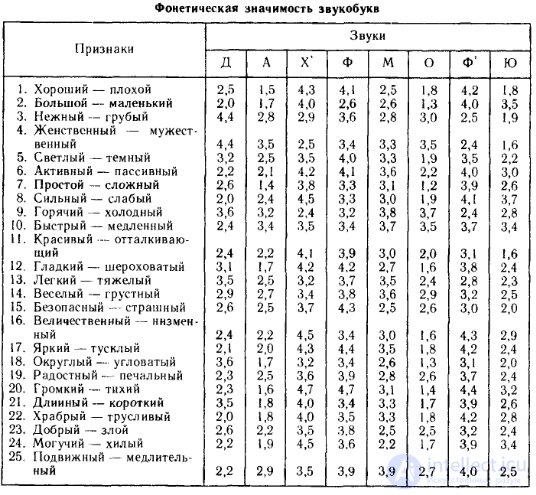
Звуки оценивались по шкале от 1 до 5 и в результате множественных опросов выводилось среднеарифметическое значение. Значимыми считались показатели больше 3,5 и меньше 2,5, если оценка для звука попадала в интервал >=2.5 и <=3.5 считалось, что звук не оказывает ярко выраженного значения в конкретной паре из шкал.
Чаще всего мы не воспринимаем осознанно звуковой образ слова, сосредотачивая всё внимание на его смысле. Тем не менее, поскольку отдельные звуки, как мы убедились, значимы, то и сочетание звуков обладает фонетической значимостью.
Журавлевым было предложено оценивать слово целиком, а не отдельные звуки, по тем же шкалам что и для звуков. Но т.к. вклад отдельных звуков разный, то и суммарный вклад должен быть разный. Например первая буква слова в 4 раза более значима чем остальные, а ударная в 2 раза. Также было замечено, что важную роль играет частота встречаемости звуков. Например в русской речи наиболее часто встречаются звуки А, О, Т, Н и значительно реже Ф, Х. Для учёта вклада частотности была разработана таблица в которой указано сколько в среднем раз употребляется звукобуква на 1000 звукобукв.
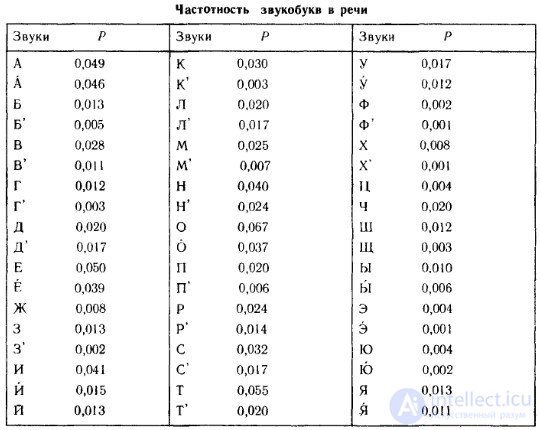
При расчёте фонетической значимости слова нужно увеличить вес средних оценок не только для первого и ударного звуков, но и для всех звуков, кроме максимально частотного в слове. Иначе говоря, нужно считать не просто средне арифметическое средних оценок всех звуков, а сначала приписать каждому звуку свой вес, свой весовой коэффициент, в зависимости от места в слове и частотности, а уж затем вычислять среднее арифметическое.
Коэффициент учитывающий разницу частотностей звуков слова (ki) можно вычислить по формуле

где Pi — частотность любого i-того звука, Pmax — максимальная частотность звука в слове.
Далее учитываем место каждого звука в слове. Коэффициент первого звука увеличиваем в 4 раза:

Коэффициент ударного звука вычисляется по формуле:

Общую фонетическую значимость слова можно вычислить по формуле:

где F — фонетическая значимость слова, fi — фонетическая значимость очередного i-того звука слова, ki — коэффициент для очередного звука.
По такому же принципу можно вычислить фонетическую окраску всего текста, суммируя фонетическую значимость отдельных слов.
Таким образом можно сделать оценку окраски значения слова или текста по 25 шкалам и сделать соответствующие выводы.
Пример такой оценки (с помощью программы ВААЛ) слова «Любовь»:
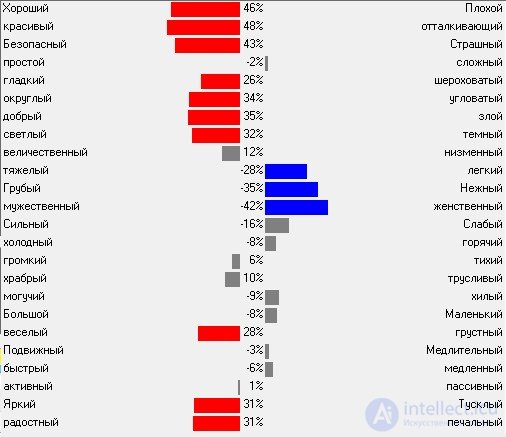
Какие можно сделать выводы из такого анализа? Достаточно очевидные — слово любовь нами воспринимается как нечто положительное, доброе и никак не отталкивающее. Результат анализа нам это весьма очевидно подтверждает. Так например программа нам говорит о том, что слово любовь воспринимается нами как нечто хорошее, красивое, доброе, женственное и нежное. И ведь это действительно так. Отбросив веру в достоверность результатов, мы всё равно осознаём, что это слово вызывает именно такие чувства в нас.
Проанализируем слово «печаль»:
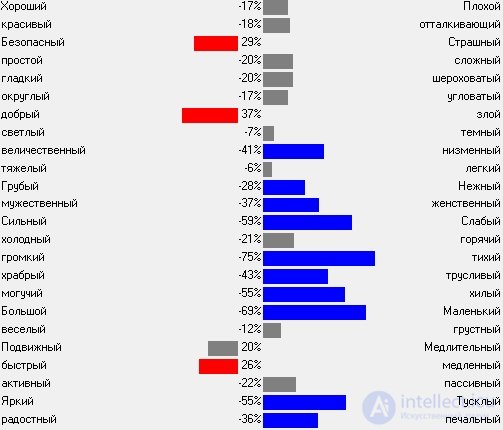
Очевидно, что слово печаль вызывает у нас более негативную окраску и программа это подтверждает.
Вполне очевидно, что результаты нельзя понимать буквально. Ведь никому не придет в голову
пытаться потрогать звук, когда говорят, что он «мягкий» или «твердый», никто не выстраивает
звуки по «росту», когда речь идет о «высоких» и «низких» звуках. Точно так же признак
«страшный» вовсе не означает, что звук Р представляет для нас какую-то опасность, признак
«горячий» отнюдь не говорит о возможности обжечь руку о звук Ж, а признак «веселый» не
значит, что звук И вызывает у нас смех.Все обнаруженные у звуков признаки нужно понимать так, что впечатления от звуков как-то
соотносятся с впечатлениями о предметах и явлениях. Если среди характеристик звука О есть
признак «большой», это означает только то, что впечатление от звука О в чем-то сходно с
впечатлением от восприятия какого-либо большого предмета или явления. Если звук Ш оказался
«темным», значит, впечатление от него чем-то напоминает нам впечатление от темного предмета
или явления.
Вы можете попробовать сами проанализировать слово or текст и посмотреть на результаты и их реалистичность.
Практический потенциал у этого метода весьма велик. Это может быть как составляющая часть обучаемости компьютера понимания смысла, сути слова и текста. Так и просто позволяет оценить тот или иной текст на воспринимаемость человеком. Например вы придумали рекламный слоган, почему бы его не проверить на воспринимаемость… вдруг всё звучит красиво, а воспринимается совсем не так как ожидалось.
Фоносемантика пока не получила достаточно широкого распространения. Назвать какие-нибудь специальные фоносемантические исследования рекламного текста трудно. Рекламный текст с точки зрения фоносемантики рассматривает С.С. Шляхова, которая раскрывает значимость фоносемантического уровня рекламного текста и дает его характеристику [7].
Today it is hardly possible to say that there are any serious scientific studies on the phonosemantics of the advertising text, although “the consideration of the advertisement text from the point of view of phonosemantics is important, since the phonosemantic level affects the human subconscious. Using the associative properties of the sound form of the word helps the addressee create a certain image of the advertised product ”[1].
There are many works related to the sound organization of the advertising text. It has been proven that “the sound organization of the advertising text is more intentional. In order to achieve the desired emotional effect, the addresser selects words based on their phonemic composition. In such a sound organization, the main role is played by the sound replay, which brings the structuring element into the text, creates the rhythm of the message ”[3].
Artistic techniques in the advertising text affect primarily the perception and memorization. Every day a person hears and reads a lot of advertising texts, therefore it is necessary to find such means that would help make the text of an advertisement memorable.
Strong means of influence is rhyme, which is a type of sound repetition or consonance. Rhyme plays an important role as a composition-sound repetition. Use rhyme should be careful. It should be supported by a general advertising concept and style. In this case, the rhyme will not cause internal dissonance and will be perceived favorably and with understanding. Here is one example of using rhyme in the advertising slogan of Clerasil, a cosmetics company: Clean and healthy skin ... and for kissing too .
Considering the phonemic composition of lexical units, the addresser carefully selects words and organizes them into a system of signals, in which sound repetition is a prerequisite for consistency. The most common types of replay sound are alliteration and assonance.
“ Alliteration is one of the ways of sound organization of speech, referring to the so-called sound repetitions and consisting in the symmetric repetition of homogeneous consonant sounds” [8]. Alliteration related words are highlighted in a statement and acquire a certain intonational significance: Major. W o about in about r about well about .
The role of assonance is less noticeable in the ad copy. However, under certain conditions (with the greatest crowding of the series and the maximum similarity of repetitive sounds), vocal repetition is also able to participate in the creation of the sound significance of the advertising text. Associated with assonance words are highlighted in the speech flow, acquiring a certain intonational significance, as in the following advertising slogan: Dabao. Cosmetics with the building itself about the nature of the doy .
“The repetitiveness of certain sounds in an advertising text not only ensures intelligibility of speech, simplicity of its perception, but also, along with lexical and grammatical means, can convey the symbolic content of a message, create emotional potential and“ dispense ”expressiveness” [4].
Thus, the sound organization of the advertising text is very important for manufacturers of products, since “The highest manifestation of the artistic value of an advertising text is its ability to be remembered, to enter everyday speech, without losing touch with the object of advertising” [6].
The techniques listed above contribute to the memorization of advertising text, increasing its suggestiveness.
However, these techniques are “on the surface”, the phonosemantic (sound-symbolic) level of the advertising text is much more difficult to organize. According to phonosemantics, the word has a phonetic meaning. Every sound of speech is perceived by native speakers quite definitely. According to A.P. Zhuravleva, the sounds of the Russian language are divided into: good (a, o, m, y) and bad (y, f, x '), feminine (f', y) and courageous (d, a, x, o, p), hot (x, f, u, g) and cold (d, m, o, n), etc. [2].
“Human knowledge and ideas about the world are fixed in the semantics of the word with the help of associative components” [5]. Studies of sound-color associativity are actively conducted and give serious results. The results of the study of this phenomenon are special computer programs: BAAL, Zvukottsvet, etc.
The VAAL special computer system (developed by V.I. Shalak, V.P. Belyanin and others. Http://www.vaal.ru/prog/free.php ) is based on the research by A.P. Zhuravleva. It allows you to evaluate the unconscious emotional impact of the phonetic structure of texts on a person’s subconscious, generate words with specified phonosemantic characteristics, evaluate the sound and color characteristics of words and texts, produce emotional and lexical analysis of texts and much more. This is how the program appreciated one of the slogans of the cosmetic company Florena (Fig. 2):
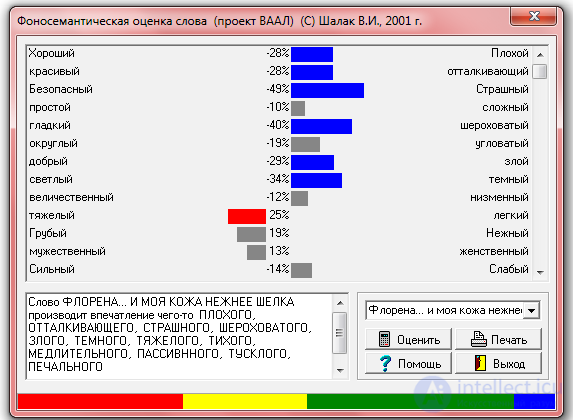
Unpleasant associations with the sound of Floren's slogan ... And my skin is softer than silk due to the low frequency of the F, F, III sounds in Russian.
The “Sound Flower” program (developed by T. Mironova, I. Plastun, L. Prokofiev) in the literal sense of the word “colors” the letter. The results are sometimes astounding. The work of the program is based on information about the average frequency of sound letters and data on the correspondence of each letter of a certain color or several colors [5].
At the first stage of the analysis of sound-color associativity of advertising slogans, each of the slogans was analyzed in the “Sound Color” program. An analysis of the slogans of cosmetic advertising companies in the BAAL and Zvukottsvet programs showed that the main colors of the sound-color associativity of the advertising companies' slogans are green (42% of all slogans), red (34%), yellow (20%) and blue (4% ). Based on these data, we can conclude that the main color of the slogans of cosmetic companies is green.
At the second stage of the work, 50 slogans of various cosmetic advertising companies were compared with their logos / posters / promotional materials / images of the advertised products to analyze the sound-color associativity of the advertising text. It was established that the color gamut of visual materials and the sound-color associativity of slogans coincide in 50% of cases.
The coincidence of colors of sound-color associativity of slogans with colors used in visual advertising may, in our opinion, contribute to the success of an advertising campaign. This is explained by the fact that the color of the slogan, although not verbally present in the text, is perceived subconsciously by the person. The repetition of this color in visual advertising can increase the impact of advertising text.
Based on the data obtained, we can conclude that the advertising companies DKS, Vishy, Oriflame, Faberlic, Princess, Loreal, Mary Kay, Florena, Lumene, Mia ”,“ Diademine ”,“ Yves Rocher ”,“ Vorozheya ”,“ One Hundred Beauty Recipes ”successfully use various favorable colors in their visual advertisements, which are maintained at the same level as the verbal row's color-and-color associativity. It can be assumed that the success of these companies is largely based on this.
We believe that deeper and more systematic research of the advertising text using the methods of phonosemantic analysis will make it possible to establish many hidden patterns of functioning and “longevity” of one or another advertisement.
1. Alekseeva, I.S. Introduction to Translation Studies [Text] / I.S. Alekseeva.-SPb .: Akademiya Publishing House, 2004.- 273s,
2. Balash, M.A. Phonosemantic structure of the text as a factor in its understanding (experimental study): Author. Abstract, Diss. ... Cand. filol. Sciences [Text] / М.А. Balash. Barnaul 1999. -15s.
3. Barkhudarov, L. S. Language and translation. Questions of general and private translation theory [Text] / L.S. Barkhudarov. - M .: Intern. Relationships, 1975 - 239c.
4. Vasina, Y. Equivalence [Electronic resource] / Y. Vasin. - Yekaterinburg. 2000 // http: //zoo/ustu/ru/inter/aeque.html
5. Types of emotions and feelings [Electronic resource] // http: //www.psi.webzone.ru.123700.htm.
6. Vinogradov, V.V. Stylistics. The theory of poetic speech. Poetics [Text] / V.V. Vinogradov. - M .: Higher school, 1963. - 479с.
7. Voronin, S.V. Basics of phonosemantics [Text] / ST. Voronin. - L .: Izd-vo LSU, 1982-244с.
8. Voronin, C. V. Phonosemantic ideas in foreign linguistics [Text] / ST. Voronin.- L .: Izd-in Leningrad State University, 1990. -199s.
9. Halperin, I.R. Selected Works [Text] / I.R. Halperin. - M .: Higher School, 2005. - 254s.
10. Gachechiladze, G.R. Deposition and poetic translation / Poetics of translation: Collection // Compiled. S.F. Goncharenko [Text] / G.R. Gachechiladze. - M .: Rainbow, 1988. -235s.
11. Gumilyov, N. Translation verse // Translation is a means of mutual rapprochement of peoples. Collection of articles [Text] / P. Gumilev.- M .: Progress, 1987. - 258s,
12. Goncharenko, S.F. Symbolic sound writing: quasi-morpheme as an internal word in the process of poetic communication // Language- ability: To the 60th anniversary of the Corr. RAP Yu.P. Karaulov [Text] / S.F. Goncharenko.-M., 1995. 189
13. Goncharenko, S.F. Poetic translation and translation of poetry [Electronic resource] / S.F. Goncharenko, 2005 // http: //orus.slavica/org/node/1734
Часть 1 Definition of phonosemantics. Classification of the meanings of sounds Phonosemantic experiments
Часть 2 Phonosemantic experiments - Definition of phonosemantics. Classification of the meanings
Comments
To leave a comment
Psycholinguistics
Terms: Psycholinguistics